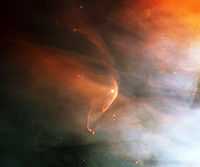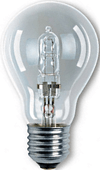Cosmic circuits

Voyager 1 has found only electrons streaming into the heliosphere from elsewhere in the galaxy. This problem set poses several problems to calculate the possibility that a simple electrical circuit is involved.
Evaluation
|
Circuits

The diagram at right suggests a simple electrical circuit.
Def. an enclosed "path of an electric current"[1] is called a circuit.
In the diagram at right are three components:
- a voltage (V), or current (i), source,
- an enclosed path, and
- a resistance, or resistor, (R).
According to Ohm's law:
With respect to an enclosed path, consider a path from outside the heliosphere, inward toward the Sun, and out again. Let the incoming electrons have 500 MeV of energy and a flux of 8.5 x 104 e- cm-2 s-1.
Def. a "time rate of flow of electric charge"[2] is called a current.
Def. "that constant current which, if maintained in two straight parallel conductors of infinite length, of negligible circular cross-section, and placed 1 metre apart in vacuum, would produce between these conductors a force equal to 2 x 10–7 newton per metre of length"[3] is called an ampere.
Def. an "amount of electrostatic potential between two points in space"[4] is called a voltage.
Problem 1

Using the energy and electron flux described above, what is the apparent current in Amperes (A), flowing toward the Sun?
Considering the Sun to be a natural light source like the halogen light bulb at right, what is the resistance (R) and the voltage (V) of this circuit?
Problem 2
If the luminosity (in Watts, W) of the Sun is 3.846 x 1026 W, pick a combination of resistance (R) and voltage (V) for this circuit.
Problem 3
If the total number of protons being carried away from the Sun by the solar wind is about 1.3×1036 per second, with 10 keV of energy, what is the proton (p+) flux away from the Sun?
What is the amperage (A) of this solar wind?
Pick a combination of resistance (R) and voltage (V) for this circuit for the luminosity of the Sun.
Problem 4
Using your electron and proton currents calculated above, where the current vector toward the Sun is the same as away from the Sun as part of the circuit, does the proton current increase or decrease the total current?
In a household circuit, the voltage may be 110 V and the current 15 A, considering it a direct current circuit, what is the number of electrons per second for these 15 Amps?
If the Sun is a 110 V source, and the number of electrons leaving the Sun in all directions is 15 Amps, what is the resistance of the enclosed path?
Problem 5
The Voyager 1 data suggests that no electrons or protons are leaving the heliosphere into the galaxy. Some of the incoming electrons may be converted into neutrons. Some are being turned back toward the Sun as part of the circuit. If ten per cent of the incoming interstellar electrons are those leaving the Sun and being turned back toward the Sun, and another portion are being neutralized by the proton solar wind, what is the maximum number that may be turned into neutrons if no electrons are lost and only their energy is used to make the Sun luminescent?
If the only electrons leaving the Sun have the same numbers and energy of the protons leaving the Sun, how many electrons are being turned into radiant energy, if 50 % are being turned into neutrons?
If the radiant energy leaving the Sun combines with incoming interstellar gamma-rays at 500 MeV or greater, what gamma-ray flux is needed to complete the circuit if half are converted to electrons?
Research
Hypothesis:
- A complete circuit exists regarding the Solar System.
Control groups

The findings demonstrate a statistically systematic change from the status quo or the control group.
“In the design of experiments, treatments [or special properties or characteristics] are applied to [or observed in] experimental units in the treatment group(s).[5] In comparative experiments, members of the complementary group, the control group, receive either no treatment or a standard treatment.[6]"[7]
Proof of concept
Def. a “short and/or incomplete realization of a certain method or idea to demonstrate its feasibility"[8] is called a proof of concept.
Def. evidence that demonstrates that a concept is possible is called proof of concept.
The proof-of-concept structure consists of
- background,
- procedures,
- findings, and
- interpretation.[9]
See also
References
- ↑ "circuit, In: Wiktionary". San Francisco, California: Wikimedia Foundation, Inc. January 27, 2014. Retrieved 2014-03-05.
- ↑ "current, In: Wiktionary". San Francisco, California: Wikimedia Foundation, Inc. February 20, 2014. Retrieved 2014-03-05.
- ↑ "ampere, In: Wiktionary". San Francisco, California: Wikimedia Foundation, Inc. February 9, 2014. Retrieved 2014-03-05.
- ↑ "voltage, In: Wiktionary". San Francisco, California: Wikimedia Foundation, Inc. January 25, 2014. Retrieved 2014-03-05.
- ↑ Klaus Hinkelmann, Oscar Kempthorne (2008). Design and Analysis of Experiments, Volume I: Introduction to Experimental Design (2nd ed.). Wiley. ISBN 978-0-471-72756-9. http://books.google.com/?id=T3wWj2kVYZgC&printsec=frontcover.
- ↑ R. A. Bailey (2008). Design of comparative experiments. Cambridge University Press. ISBN 978-0-521-68357-9. http://www.cambridge.org/uk/catalogue/catalogue.asp?isbn=9780521683579.
- ↑ "Treatment and control groups, In: Wikipedia". San Francisco, California: Wikimedia Foundation, Inc. May 18, 2012. Retrieved 2012-05-31.
- ↑ "proof of concept, In: Wiktionary". San Francisco, California: Wikimedia Foundation, Inc. November 10, 2012. Retrieved 2013-01-13.
- ↑ Ginger Lehrman and Ian B Hogue, Sarah Palmer, Cheryl Jennings, Celsa A Spina, Ann Wiegand, Alan L Landay, Robert W Coombs, Douglas D Richman, John W Mellors, John M Coffin, Ronald J Bosch, David M Margolis (August 13, 2005). "Depletion of latent HIV-1 infection in vivo: a proof-of-concept study". Lancet 366 (9485): 549-55. doi:10.1016/S0140-6736(05)67098-5. http://www.ncbi.nlm.nih.gov/pmc/articles/PMC1894952/. Retrieved 2012-05-09.
External links
- African Journals Online
- Bing Advanced search
- Google Books
- Google scholar Advanced Scholar Search
- International Astronomical Union
- JSTOR
- Lycos search
- NASA/IPAC Extragalactic Database - NED
- NASA's National Space Science Data Center
- Office of Scientific & Technical Information
- Questia - The Online Library of Books and Journals
- SAGE journals online
- The SAO/NASA Astrophysics Data System
- Scirus for scientific information only advanced search
- SDSS Quick Look tool: SkyServer
- SIMBAD Astronomical Database
- SIMBAD Web interface, Harvard alternate
- Spacecraft Query at NASA.
- SpringerLink
- Taylor & Francis Online
- Universal coordinate converter
- Wiley Online Library Advanced Search
- Yahoo Advanced Web Search
| ||||||||||||||||||||||||||||||||
| ||||||||||||||||||||||||||||||||||||||||||||
| |||||||||||||||||||||||||||||
| |||||||||||||||||||||||||||||||||||
| |||||||||||||||||||||||||||||||||||||||||
![]() This is a research project at http://en.wikiversity.org
This is a research project at http://en.wikiversity.org
| |
Development status: this resource is experimental in nature. |
| |
Educational level: this is a research resource. |
| |
Subject classification: this is an astrophysics resource. |
